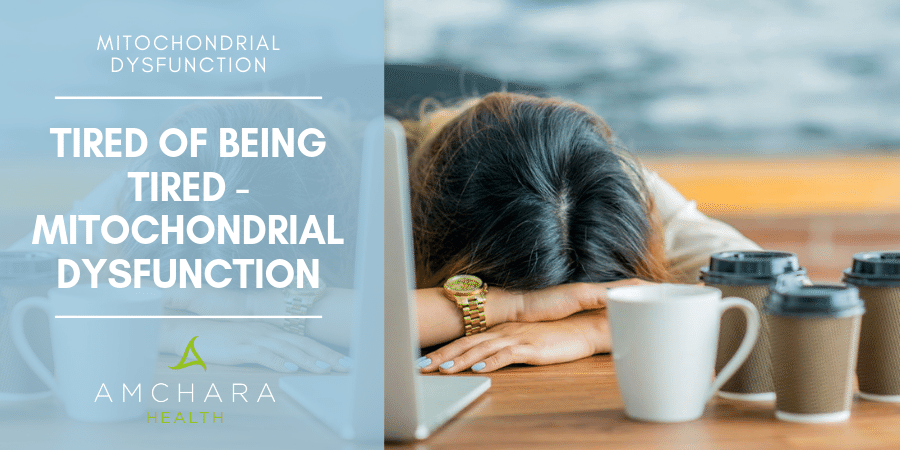Mitochondria are miniscule cellular structures within the cells of our bodies.
These little structures are known as the ‘power house’ of the cell as they play a vital role in energy production.
Mitochondria are present in nearly every cell in the body and some areas contain higher levels of mitochondria than others.
For example, muscle cells have a high concentration of mitochondria whereas nerve cells contain far less.
Mitochondrial dysfunction occurs when there are problems with the functioning of the mitochondria, which can affect not only energy levels but also other aspects of health.
Feeling tired all the time (TATT) and long term, or chronic, fatigue can impact day to day activities.
Our mission is to provide you with insightful information. We always take an evidence-based approach and aim to provide you with actionable knowledge and tips to help you on your journey to optimal health. In this article we take a look at how the mitochondria influence health and the best ways to keep your mitochondria healthy.
What are mitochondria?
The mitochondria float around in the gel-like fluid found within cells.
They have a rod shape and are around the same size as some bacteria.
The number of mitochondria can vary depending on energy demands.
Heart muscle cells may contain up to 4000 mitochondria per cell.
Liver cells may have in the region of 1000-2000 mitochondria.
Within the mitochondria several functions take place, including energy production in the process termed cellular respiration.
Mitochondria use nutrients from food to make the ‘energy currency’ ATP.
Other mitochondrial functions include:
- Assisting with haemoglobin production – required for healthy blood and oxygen transportation
- Aiding in calcium balance within cells, protecting cells from calcium overload -important for heart function (1)
- Supporting nerve conduction through assisting with neurotransmitter release
- Playing a role in building certain hormones such as oestrogen and testosterone
- Involved in metabolic pathways that build, breakdown and recycle cellular building blocks, therefore playing a role in cell death, called apoptosis. Dysfunction in apoptosis is linked to cancer (2), auto-immune conditions and neurodegenerative conditions like Alzheimer’s and Parkinson’s. (3)
- Aiding detoxification – in liver cells the mitochondria have enzymes that detoxify ammonia
What is mitochondrial dysfunction?
Due to the fact that mitochondria play many vital roles in the body, when mitochondria are not able to function fully, as in mitochondrial dysfunction, signs and symptoms may present, including:
- Fatigue
- Exercise intolerance
- Intolerance to environmental temperature changes
- Muscle weakness or pain
- Low blood pressure
- Slow digestive function
- Brain fog, memory issues
Many of these symptoms exist in conditions like chronic fatigue syndrome (CFS), also called ME, and also in fibromyalgia.
It is thought that dysfunction in mitochondria is a key factor in the development of these conditions.
It is important to also note the existence of mitochondrial disease which is different from mitochondrial dysfunction.
Mitochondrial disease relates to an inherited genetic issue affecting the mitochondria’s ability to produce enough energy which can significantly disrupt organ function.
It can occur in adulthood but mostly occurs in childhood.
It can affect almost every organ in the body and can lead to poor growth, muscle weakness and neurological issues like seizures.
Oxidative stress and mitochondrial function
Mitochondria are very sensitive and are highly influenced by free radical damage.
Free radicals are unstable molecules that attack body cells causing damage: they can be produced in response to a variety of situations including normal body processes, vigorous exercise and environmental factors.
An increase in free radicals can trigger the inflammatory response.
Antioxidants provide part of the body’s defence mechanisms against the damage caused by free radicals.
The body produces its own antioxidant enzymes, called endogenous antioxidants, to combat free radicals. The food we eat can also provide an abundance of antioxidants.
If there are not enough antioxidants available to ‘mop up’ the damage caused by free radicals, a situation called oxidative stress occurs.
This may occur because the nutrients required for the body to make antioxidants are lacking, or dietary antioxidant intake is low.
Or it may be a high level of free radicals are being produced due to exposure to many damaging factors.
Oxidative stress leads to mutations in DNA in mitochondria, alters the energy production process and affects mitochondrial defence mechanisms (4).
It is clear that oxidative stress has a major link with mitochondrial dysfunction and several diseases including:
- Schizophrenia (5)
- Bipolar disease (6)
- Alzheimer’s (7)
- Parkinson’s
- Chronic fatigue syndrome/ME (8)
- Fibromyalgia (9)
- Autism spectrum disorders (10)
- Lupus (11)
Factors involved
The modern world is full of factors that can play a role in increasing free radicals, oxidative stress and damage to mitochondria.
A combination, or accumulation, of these factors may lead to mitochondrial dysfunction.
| Poor nutrition | High sugar or refined carbohydrate intake
High saturated fat intake Processed foods Chargrilled, barbequed or burnt food Low fruit and vegetable intake |
| Poor gut health | ‘Leaky gut’
Dysbiosis |
| Infections | Parasites, bacteria, viruses, moulds (12) |
| Environmental toxins | Chemicals and heavy metals (13) found in cosmetics, toiletries, tap water, air (14), pesticides (15), fertilisers, plastics (16) |
| Stress | Psychological, physical (such as excess exercise), emotional (17,18) |
| Lifestyle factors | Lack of sleep (19), smoking, recreational drug use, sunbathing or use of tanning machines |
| Prescription medication | Through impact on gut lining, digestion, nutrient absorption, microbiome changes, damage to mitochondrial DNA (20) |
Testing
Many of the signs and symptoms of mitochondrial dysfunction are similar to other conditions and so it can be beneficial to carry out functional tests.
Knowing exactly which tests are most appropriate in your individual circumstances can be difficult to ascertain.
When it comes to testing mitochondrial function there are a number of options.
ATP (energy currency) production, transport and recycling can be assessed with a blood test.
This comprehensive test can indicate which particular stages of ATP production may be affected within mitochondria.
A simple urine test called the OAT test (Organic Acid Test) can detect a variety of different markers that can be used to assess certain aspects of mitochondrial function, oxidative stress, gut microbial balance, overgrowth of yeast or unwanted bacteria, nutritional and antioxidant deficiencies and neurotransmitter balance.
Although the test is simple to perform, interpreting results can be much trickier.
This is where guidance and support from an experienced practitioner comes in.
As other factors may be involved it can sometimes also be useful to test the function of the thyroid gland, gut function through a stool test, check heavy metals and toxin levels, detoxification ability and salivary stress hormone levels.
Restoring mitochondrial function
Using functional tests will give very specific information for each individuals circumstance and an approach to support the mitochondria back to full health can be varied and very personal.
No two people will have exactly the same issue, predisposing factors, triggers, results or therapy approach.
There are steps that are important to consider when tackling mitochondrial functioning and the following are important:
-
Anti-inflammatory diet
What you eat can affect the balance of inflammation and oxidative stress in the body.
A focus on an antioxidant rich diet which is low in foods that are known to contribute to oxidative stress can help to protect the mitochondria.
Fruit and vegetables
Aim to eat an abundance of fresh fruit and vegetables.
They are rich in many types of different antioxidants as well as containing many different vitamins.
Antioxidants work better together; once an antioxidant has been used to ‘mop up’ a free radical it needs another antioxidant to come along and prevent it from becoming a damaging molecule itself.
For this reason, eating a wide array of different fruits and vegetables typically ensures an adequate variety of antioxidants.
Choose from a variety of different colours and aim to eat 8-10 portions of fruit and vegetables a day, with an emphasis on vegetables.
Using a rainbow food chart can be useful in tracking your daily intake.
Beneficial antioxidants for mitochondrial health include:
Vitamin C – guava, papaya, citrus fruits, broccoli, tomatoes, strawberries, blackcurrants, apples, red/green peppers, Brussels sprouts, watercress, cauliflower, kiwi
Vitamin E – avocados, nuts, wholegrains, green leafy vegetables, olives, olive oil.
Carotenoids – tomatoes, carrots, peppers, spinach, pumpkin, citrus fruits, dark green leafy vegetables, apricots.
Flavonoids – berries, cherries, onions, apples, pomegranates, basil, oregano, rosemary, parsley.
Omega-3
Omega-3 fatty acids are precursors to natural anti-inflammatory molecules and, as they cannot be made in the body, a good dietary intake is required.
Aim to eat at least 3 portions of oily fish a week, such as salmon, herring, trout, sardines, mackerel and pilchards. Including seeds such as flax and chia seeds and walnuts also contributes to omega-3 levels.
Keeping a good balance between omega-3 and omega-6 rich foods is also a key step as too much omega-6 in the diet can prevent omega-3 from being used effectively.
Highly processed foods, ready meals, takeaways, vegetable oils and margarines are often high in omega-6 and are worth reducing.
Choosing organic grass fed meat and poultry over grain fed helps provide a better omega- 3 to 6 balance (21).
Use spices
Not only do these liven up foods but they also bring a variety of health benefits.
Turmeric contains curcumin, which is responsible for the distinctive yellow/orange colour.
Curcumin is a potent antioxidant well known to reduce inflammation (22) and rodent studies suggest that it may protect mitochondria from oxidative damage (23).
Ginger also has anti-inflammatory properties (24) and is a great addition to juices, smoothies or a stir fry.
Promising research in rodents confirm that ginger not only acts like an antioxidant but can influence free radicals and damage to mitochondria (25).
Drink green tea
A common drink in eastern cultures, green tea is rich in many antioxidants including epigallocatechin gallate (EGCG) which has been shown to have many influences on mitochondrial function and health (26).
It is thought that between 5-10 cups of green tea a day may be beneficial.
Keep inflammatory foods low
It makes sense that if you wish to reduce inflammation, avoiding or reducing foods that cause inflammation in the body is wise. Foods linked to inflammation include:
- Sugar (27)
- Gluten containing grains
- Processed and packaged foods
- Trans fats
- Excess alcohol
- Fried or charred foods
- Processed red meats like sausages, ham, bacon and salami
- Dairy
-
Glutathione rich foods
Glutathione is often called the ‘master antioxidant’ – it plays a key role in reducing oxidative stress as it has powerful antioxidant properties.
Some foods naturally contain glutathione, although processing and cooking these foods can significantly decrease the availability of glutathione.
Top glutathione foods include asparagus, okra, avocados, spinach, broccoli, tomatoes, carrots, citrus fruits and courgettes.
But the majority of glutathione comes from production within the body.
A number of nutrients are involved in glutathione production in the body and these include the amino acids glutamate, glycine and cysteine.
Cysteine is present in protein rich foods such as meat, poultry, fish, eggs, quinoa and buckwheat.
These foods are also rich in the amino acid methionine, which may be used to make cysteine.
Certain plant chemicals can also stimulate glutathione production, and these include sulforaphane, indole-3-carbinol and chrolophyll found in brassica and dark green leafy vegetables.
The minerals selenium and zinc are also important for glutathione enzyme production.
Good food sources of selenium include brazil nuts, fish, shellfish and lean meat and poultry.
Zinc rich foods include oysters, lean beef and chicken, pumpkin seeds, lentils and hemp seeds.
-
Eliminate toxins
We live in an increasingly toxic world and are surrounded by air pollution, toxins in water supplies – at times it can feel hard to avoid toxins.>
But you can take some simple steps to help reduce your exposure to toxins.
Using a water filter, choosing organic foods, avoiding plastics for storing food, avoiding chemical laden cosmetics, toiletries and cleaning products and opting for more natural versions can all make a difference.
-
Nutritional supplementation
Specific nutrients are required to support the energy production pathways within mitochondria and although food will contribute some of these nutrients a higher level may be required to restore mitochondrial functioning.
The use of high quality, excipient free nutritional supplements may help to ‘kick-start’ mitochondrial function.
The following nutrients may be of use:
- Vitamin B3 (28)
- Vitamin B3
- Vitamin B12
- Magnesium
- D-ribose
- Creatine (29)
- Acetyl-L-carnitine
- Coenzyme Q10 (30)
Targeting inflammation and oxidative stress with nutritional supplements further protects mitochondrial function and reduces damage to the mitochondria:
-
Increase mitochondrial biogenesis
Certain circumstances can stimulate mitochondria to change their numbers, size and enzyme activity.
This is called mitochondrial biogenesis.
In order to restore full health back to mitochondrial functioning it can be beneficial to support mitochondrial biogenesis through particular lifestyle alterations.
Physical exercise is known to support many functions within the body and a sedentary lifestyle is now being linked to numerous types of chronic illnesses.
Research has shown that mitochondrial enzyme activity and number of mitochondria are enhanced through regular exercise (33).
The type of exercise is important, and a 2014 review reported that people who were not used to regular exercise showed improvements in mitochondrial biogenesis from most types of exercise.
The key was to keep it regular.
For maximum benefit, and for those people who already regularly participate in exercise, High Intensity Interval Training (HIIT) such as sprint interval training, gave the best support.
The review also showed that doing resistance training (using weights or body resistance) after cardiovascular exercise also stimulated mitochondrial biogenesis (34).
As two of the major symptoms associated with mitochondrial dysfunction are fatigue and exercise intolerance, it is wise to start exercise slowly and to pace yourself.
As the mitochondria become more healthy and oxidative stress reduces, tolerance to physical activity will increase.
Mitochondrial biogenesis has also been found to increase after calorie restriction.
Allowing adequate nutrition but keeping calorie intake low may increase expression of certain genes involved in mitochondrial biogenesis and also allow for damaged mitochondria to be broken down (35).
Studies indicate that whole-body energy efficiency may be increased and there may be less oxidative stress due to fewer free radicals being produced.
The 5:2 diet involves calorie restriction on two days of the week and consuming a normal level of calories on the other 5 days ensuring there is an opportunity to incorporate vital foods and nutrients for supporting mitochondria, energy levels and reducing inflammation.
Care should be taken with adopting this type of eating pattern, depending on the level of mitochondrial dysfunction.
-
Lifestyle alteration
Lifestyle choices may often be a factor in the development of mitochondrial dysfunction and as noted a degree of lifestyle alterations will often be required.
Rest is vital to support energy pathways and getting a good night’s sleep is imperative.
In fact, sleeping well every night should be a major focus.
Studies show that people who have insomnia, suffer from broken sleep or experience jet lag have a higher level of pro-inflammatory molecules (36).
Poor sleep contributes to oxidative stress.
Sleep is also a time when the body repairs and regenerates – a vital process for removing damaged particles within cells, including damaged mitochondria.
Training your circadian rhythm and putting it back in balance, using good exposure to daylight in the mornings, can aid in improving sleep patterns.
Avoiding alcohol, smoking and recreational drugs will prevent a drain on vital nutrients, reduce free radicals and allow the body to rebalance.
Stress can be a major factor in mitochondrial dysfunction and so stress management is important.
There may be many aspects of your life that need addressing and stress reduction techniques can be useful.
Seeking advice from a counsellor, behavioural therapist or NLP practitioner can help to break the rumination and behaviours associated with stress.
The road to recovery may be a long one but making the right changes can significantly improve mitochondrial function.
The support of an experienced practitioner can ensure you are on the right track to optimal health.
Do you suspect your mitochondria are not functioning correctly?
Have you been using natural methods to support your energy?
We believe that sharing knowledge and experience enhances other people’s journey to full health.
Share your personal experience with others below, tell us what worked for you.
READ THIS NEXT:




